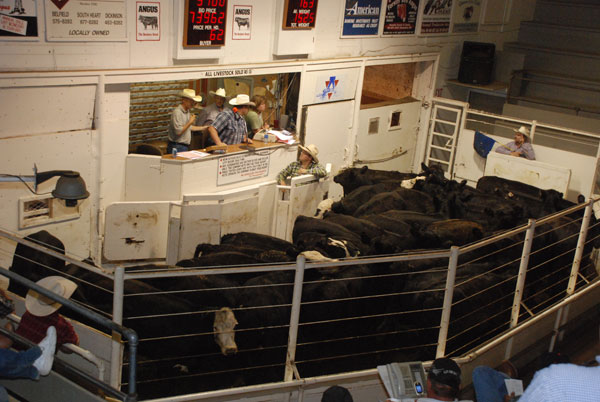Outside Markets Drag On Cattle Prices
“Tight numbers of feeders will continue to support cash feeder cattle prices, while high feed costs and the fed market’s inability to push beyond record levels near $130 will continue to keep those feeder cattle markets at bay,” AMS analysts say.
October 27, 2012

Despite the previous week’s bullish Cattle on Feed report, bearish outside markets and the continued tug-of-war between feedlots, packers and wholesalers kept a lid on cash and futures cattle prices.
Though true yearling cattle brought steady money to $2 higher at auction last week, calves continued to sell at an erratic pace—from $3 higher to $3 lower—according to the Agricultural Marketing Service (AMS).
“Central and southern Oklahoma remain the hot spot for lightweight calves to turn out on rapidly improving wheat pastures,” AMS analysts said Friday. “Similarly, the Northern Plains is the best place to sell 700-900 lb. feeders, many of which are only about nine months old, but have had the genetics and husbandry to maximize growth.”
Those may be the kind of buyers described by the market reporter at Ozarks Regional Stockyards in West Plains, MO, Wednesday where steers sold steady to $2 higher and heifers traded $2-$4 higher. “A few buyers didn’t show, others watched from the sideline, but those that were in the market were definitely on a mission and paid little mind to anything except trying to load trucks with the right kind,” explained the reporter.
After expiring October, Feeder Cattle futures closed an average of $2.74 lower week-to-week in the front five contracts. Live Cattle futures closed an average of $1.26 lower across the board week-to-week.
Headwinds in the futures pits came despite wholesale beef values that rallied most of the week. Once again, Choice daily cutout values approached $200 but failed to cross the threshold. Although daily wholesale beef prices ended the week about even with the previous Friday, Choice closed the week $2.56 lower than the week’s high achieved on Wednesday at $199.38. Select closed $4.22 lower than the week’s high, also achieved Wednesday at $183.92.
Apparently traders continue to question demand strength with already historically high retail beef prices in tandem with increasing carcass weights.
Industry At A Glance: Carcass Weights Set Record High
On the one hand, even with third-quarter Gross Domestic Product (2%) slightly higher than anticipated, major U.S. financial indices tumbled during the week beneath the weight of anemic quarterly earnings reports.
The monthly report from the Federal Open Market Committee (FOMC) was less than bullish, too: “Information received since the FOMC met in September suggests that economic activity has continued to expand at a moderate pace in recent months. Growth in employment has been slow, and the unemployment rate remains elevated. Household spending has advanced a bit more quickly, but growth in business fixed investment has slowed. The housing sector has shown some further signs of improvement, albeit from a depressed level. Inflation recently picked up somewhat, reflecting higher energy prices. Longer-term inflation expectations have remained stable.”
Speaking to the sharply lower tone of the futures market Thursday, Steve Meyer and Len Steiner explained in Friday’s CME Group Daily Livestock Report, “…market participants remain wary of a number of bearish signals. On the macro front, slowing global commodity demand remains a concern, especially with China data showing the economy there has slowed down considerably compared to the torrid pace of last year. China growth was up 9.2% in 2011 and Chinese official forecast is for 7.5% this year…”
As for carcass weights, according to analysts at the Livestock Marketing Information Center (LMIC) this week, through the first three quarters this year, steer dressed weights averaged 2% (about 17 lbs.) heavier than last year. However, those analysts note, “Year-on-year increases over 10 lbs. are not unusual and have occurred eight times on an annual basis in the last 25 years...Steer carcass weights are forecast to be in line with the normal seasonal pattern for the balance of this year and may have already peaked. For the year, steers may average 17 lbs. above 2011’s.”
Cash fed cattle sales opened up Thursday at prices mostly steady with the previous week. Live prices of $125-$127/cwt. reflected some trade 50¢ lower in the Texas Panhandle and $1 higher in Nebraska and the western Corn Belt. Dressed sales sold mostly steady at $197 in Nebraska.
“Tight numbers of feeders will continue to support cash feeder cattle prices, while high feed costs and the fed market’s inability to push beyond record levels near $130 will continue to keep those feeder cattle markets at bay,” AMS analysts say.
About the Author(s)
You May Also Like





